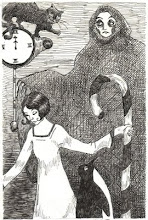 This past weekend my Darling Inamorato and I paid a truly delightful visit to the Brooklyn Museum with the purpose of seeing the Norman Rockwell exhibit (which we did!), but we also saw many other beautiful and wondrous things.
This past weekend my Darling Inamorato and I paid a truly delightful visit to the Brooklyn Museum with the purpose of seeing the Norman Rockwell exhibit (which we did!), but we also saw many other beautiful and wondrous things.Norman Rockwell: Behind the Camera was a great deal of fun and also served to illustrate how both underrated and maligned he has been in recent decades. Rockwell was one of the best commercial illustrators who has ever lived, and this exhibition’s purpose is to show how he used meticulously staged photographs to create his images. Rockwell is so often spoken of as if his work is saccharine, or even embarrassing. It isn’t. As I quoted Elizabeth Peyton (another representational artist who works from photographs) saying, "If it [art] can be understood, it [is thought to be] somehow dumb". And she has a point.
I think sometimes people assume that if they understand something, it’s simple. But it’s not. Rockwell in some ways painted an idealized America, but he also had a real talent for grotesquerie. Just compare the faces in his illustrations to what we look at in magazines and on television today. Seemingly all character has been erased in favor of blank, perfect uniformity. It's downright unAmerican. And my goodness could he paint. There were a few pencil sketches on view, and I wish there had been more. They're full of so much life, and I really do need to learn how to paint properly. But enough about me and my problems.
One of the issues with Rockwell is that he does, admittedly, paint a very narrow view of the world. This is likely where the limits of being a commercial, rather than a fine artist come into play. One must please the client, and there were intimations in the exhibit of a contentious relationship with the Saturday Evening Post. In the 40s and 50s they had policies abut how African Americans were portrayed (subservient, secondary) with which Rockwell disagreed. Later in his career, he painted some remarkable work depicting the murders of Cheney, Goodman and Schwerner, and of other civil rights scenes. I wish there had been a little more about his relationship with his long time employer, but I suppose that sort of discourse is better suited to a book that a gallery show. Looking around at the people visiting the exhibit, I saw real enjoyment. People were pretty uniformly happy and engaged. People like looking at other people and always will.
One of my favorite things about the galleries at the Brooklyn Museum is that the American art is hung thematically, so that there's a really delightful mix. I feel as if I could continuously keep going back and never get tired. One highlight was an early Edison film of Coney Island.Some unfortunate "comedy" aside, seeing what Coney looked like during its real glory days was so exciting, and made me realize doubly, triply, what a shame it is that it's all been plowed under. One really wonders what people are thinking sometimes. See part one, below:
Whenever I go to the Brooklyn Museum, I always wind up asking the same question: Why don't I go more often? After all, it is within walking distance of my house. Maybe visiting less frequently serves to keep it special. I certainly do live in the City of Kings!
Whenever I go to the Brooklyn Museum, I always wind up asking the same question: Why don't I go more often? After all, it is within walking distance of my house. Maybe visiting less frequently serves to keep it special. I certainly do live in the City of Kings!
Norman Rockwell: Behind the Camera runs through April 10. Information about visiting the Brooklyn Museum can be found here. For a large selection of Norman Rockwell Saturday Evening Post covers available for purchase go here.
(Inamorato's brilliant take can be found here)

















No comments:
Post a Comment